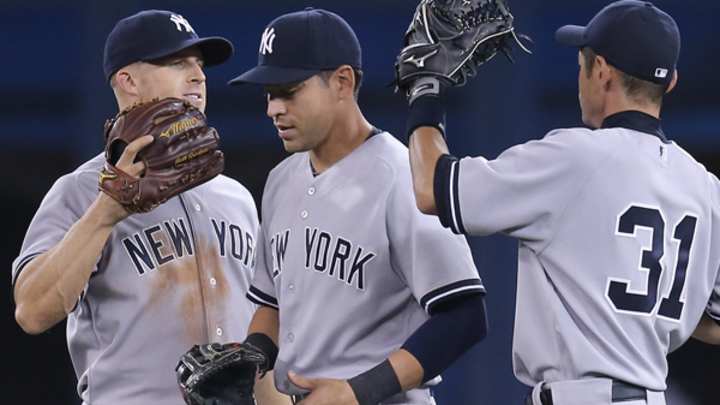Post-Robinson Cano Yankees are in first place, but can they stay there?

Buoyed by new arrivals like jacoby Ellsbury, New York sits in first in the AL East. (Tom Szczerbowski/Getty Images)

In making his return to Yankee Stadium on Tuesday to face his former team for the first time, Robinson Cano finds the Yankees in a familiar position: First place. Having poured they money they saved on Cano (who signed a 10-year, $240 million deal with Seattle), and then some, into a quartet of high-priced free agents, the Yankees are riding high in the early going. But is that early success an April illusion, or are the post-Cano Yankees a serious contender?
The first indication that the Yankees are playing over their heads is their run differential. New York has allowed eight more runs than it has scored thus far this season. To put that in context, the only other team in baseball that currently has a winning record but a negative run differential is the Phillies, a team that is just one game over .500 in fourth place and more than half of whose wins have come against the three last-place teams in the National League: The Marlins, Cubs, and Diamondbacks.
Looking at third-order wins—which take things a step further by calculating a team's expected runs scored and allowed based on the components of run scoring (hits, walks, stolen bases, etc.), then calculating expected wins and losses based on those run totals—the Yankees have played to the level of an 11-14 team despite their actual 15-10 record. Third-order wins also adjust for the quality of a team's opponents. The Yankees have played seven different teams thus far this year; not one of them currently boasts a winning record.
That's not particularly encouraging, but it's worth noting that one reason the Yankees have had such a weak schedule thus far is that they are the only team in their own division with a winning record. There are two ways to look at that. The first is that, given that the bulk of their schedule comes against intra-division opponents (76 games to be exact), the Yankees should be able to continue to fatten up on their weak division rivals. The second is that it's early for everyone, and even though the Red Sox and Rays have even worse run differentials than New York, they won't stay down for long. Indeed, the Rays' third-order winning percentage is .553, and the Red Sox trail the Yankees by a mere fraction of a win by the same measure.
The latter scenario sounds more likely, but there's reason to believe that the Yankees are underperforming to some degree as well. Obviously I don't mean in terms of wins and losses, but if you look at the individual performances of the Yankees' players in the context of that 11-14 third-order record, they look more like a team that hasn't quite hit its stride yet.
At the plate, free agent additions Jacoby Ellsbury and Carlos Beltran are off to strong starts, but neither is out of line with the player's established rate of production. Meanwhile, Brian McCann hasn't started hitting yet, and Mark Teixeira missed half of April with a hamstring strain. Outside of rookie third baseman Yangervis Solarte (.301/.400/.452), none of the Yankees' bats is exceeding expectations, and the result is a New York offense that is a tick below average in run scoring. Given the shortcomings in their infield, that needle may not move much, but outside of the ever-present threat of injury, there's no reason to expect regression or collapse, while there is reason to expect greater contributions from McCann and Teixeira.
On the mound, the Yankees have gotten huge early performances from Masahiro Tanaka and Michael Pineda, despite the latter's pine tar controversy, but they have also lost Ivan Nova for the year to Tommy John surgery, were without closer David Robertson for two weeks due to a groin strain, and have seen veterans CC Sabathia and Hiroki Kuroda struggle. Kuroda is 39 and Sabathia has a ton of mileage on his left arm and has seen his velocity wane in recent years, so there are reasons to be concerned about both. However, Kuroda's current 5.28 ERA is largely the result of one bad start (he was at 4.07 before being lit up by the Angels on Friday), and Sabathia has been steadily improving, with his game score increasing in each of his last four starts after his disastrous outing on Opening Day. Again, there is as much or more room for improvement there as there is for regression and collapse.
Getting more from McCann, Teixeira, Kuroda, Robertson, and perhaps Sabathia could improve the Yankees' base performance, improving their run differential such that, when their actual win-loss record record trends closer to their Pythagorean record, the regression isn't as severe as the current gap would suggest. The end result could wind up looking a lot like last year's 85-win pace, albeit with a firmer foundation (the Yankees' third-order record last year was 72-90).
The obvious caveat to all of that is the risk of further injury. That's a concern for every team, but in the Yankees' case its amplified by the age of their lineup and the individual injury histories and risk factors of some of their key players. Weighted by playing time, the average Yankees batter this season has been 33 years old, the oldest in baseball by two years (over the Phillies', of course). To that, you can add in the problematic recent injury histories of Teixeira, Ellsbury, Derek Jeter, Brett Gardner, and Brian Roberts, three of whom exceed that average age. On the pitching staff, in addition to Kuroda's age and Sabathia's mileage, Pineda is coming off two years lost to a shoulder injury, and Tanaka endured some extreme pitch counts in Japan.
